Change Management: Organizational Culture and Resistance to Change
VerifiedAdded on 2020/03/13
|8
|2020
|67
Essay
AI Summary
This essay delves into the critical aspects of organizational change management, focusing on the inevitability of change within organizations due to internal and external factors. It examines the common resistance employees exhibit towards these changes and explores the underlying causes, including selective perception, lack of confidence, fear of job loss, poor engagement, and habit. The essay provides an overview of relevant theories, such as the changeability and emotionality framework, which categorizes resistance based on opinions, psychological reactions, convictions, and personality. It then outlines practical strategies for overcoming resistance, emphasizing the importance of understanding the change process. The essay highlights Lewin's three-step model of change management – unfreezing, transition, and refreezing – as a successful approach for facilitating organizational change, ultimately concluding that effective change management requires identifying and addressing the reasons behind resistance to ensure positive outcomes.
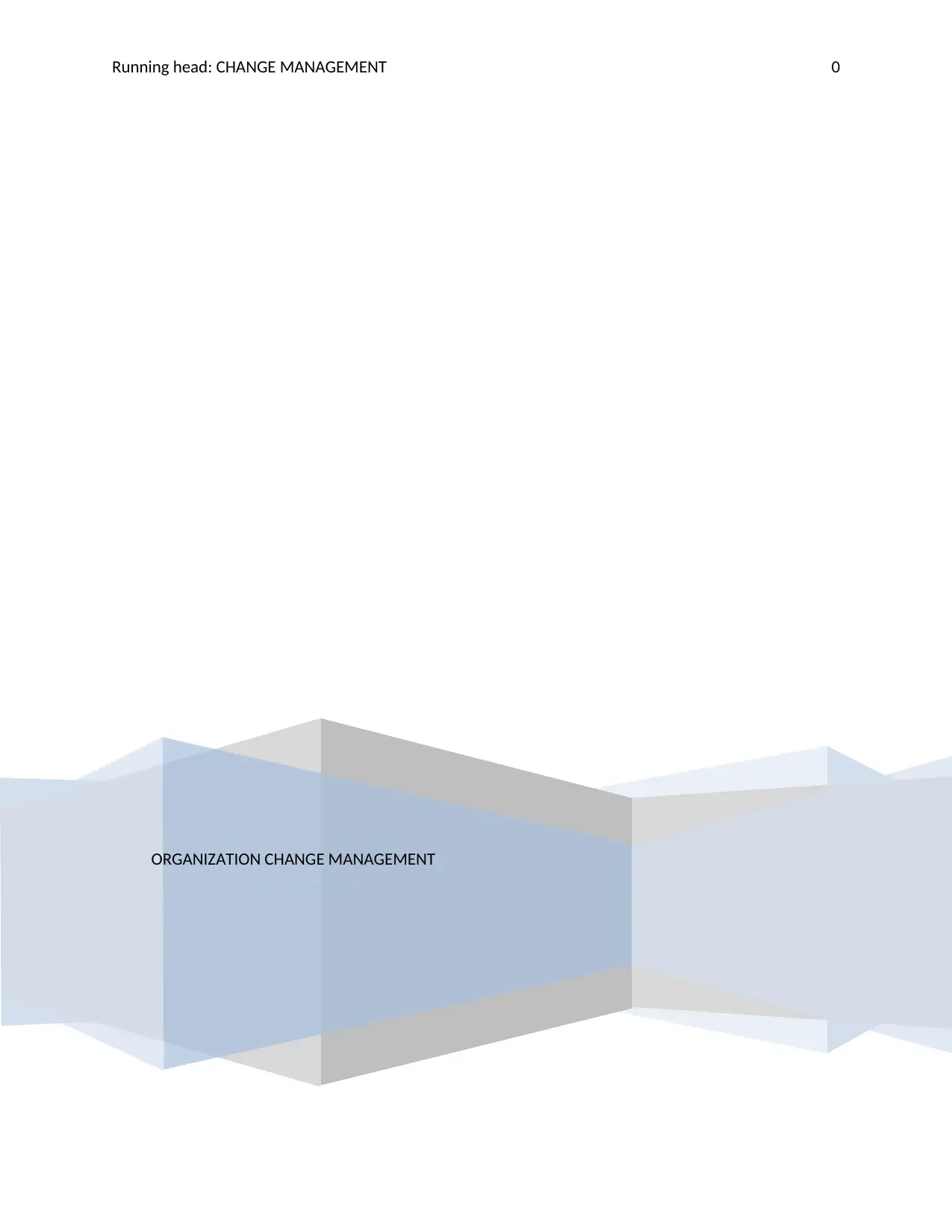
Running head: CHANGE MANAGEMENT 0
ORGANIZATION CHANGE MANAGEMENT
ORGANIZATION CHANGE MANAGEMENT
Paraphrase This Document
Need a fresh take? Get an instant paraphrase of this document with our AI Paraphraser
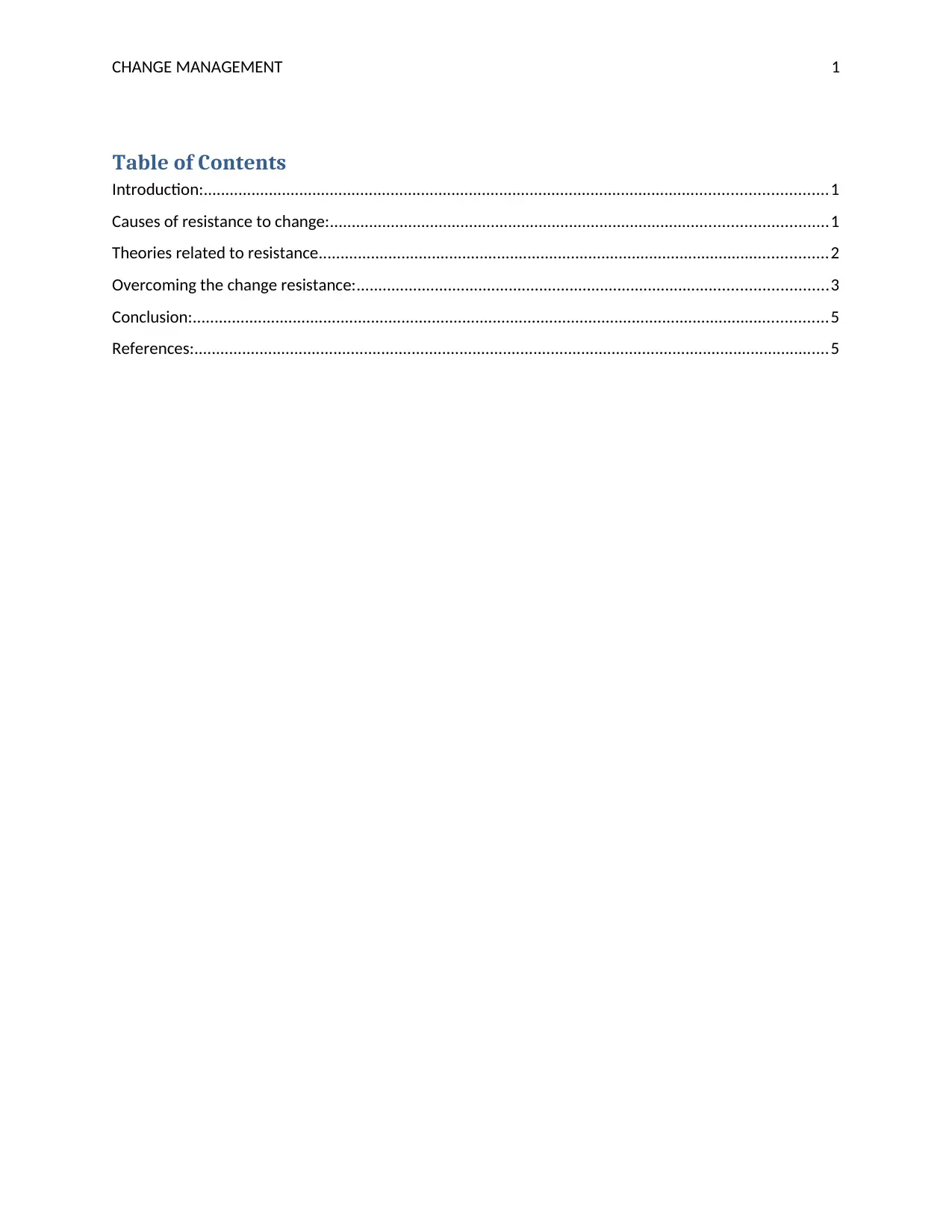
CHANGE MANAGEMENT 1
Table of Contents
Introduction:...............................................................................................................................................1
Causes of resistance to change:..................................................................................................................1
Theories related to resistance.....................................................................................................................2
Overcoming the change resistance:............................................................................................................3
Conclusion:..................................................................................................................................................5
References:..................................................................................................................................................5
Table of Contents
Introduction:...............................................................................................................................................1
Causes of resistance to change:..................................................................................................................1
Theories related to resistance.....................................................................................................................2
Overcoming the change resistance:............................................................................................................3
Conclusion:..................................................................................................................................................5
References:..................................................................................................................................................5
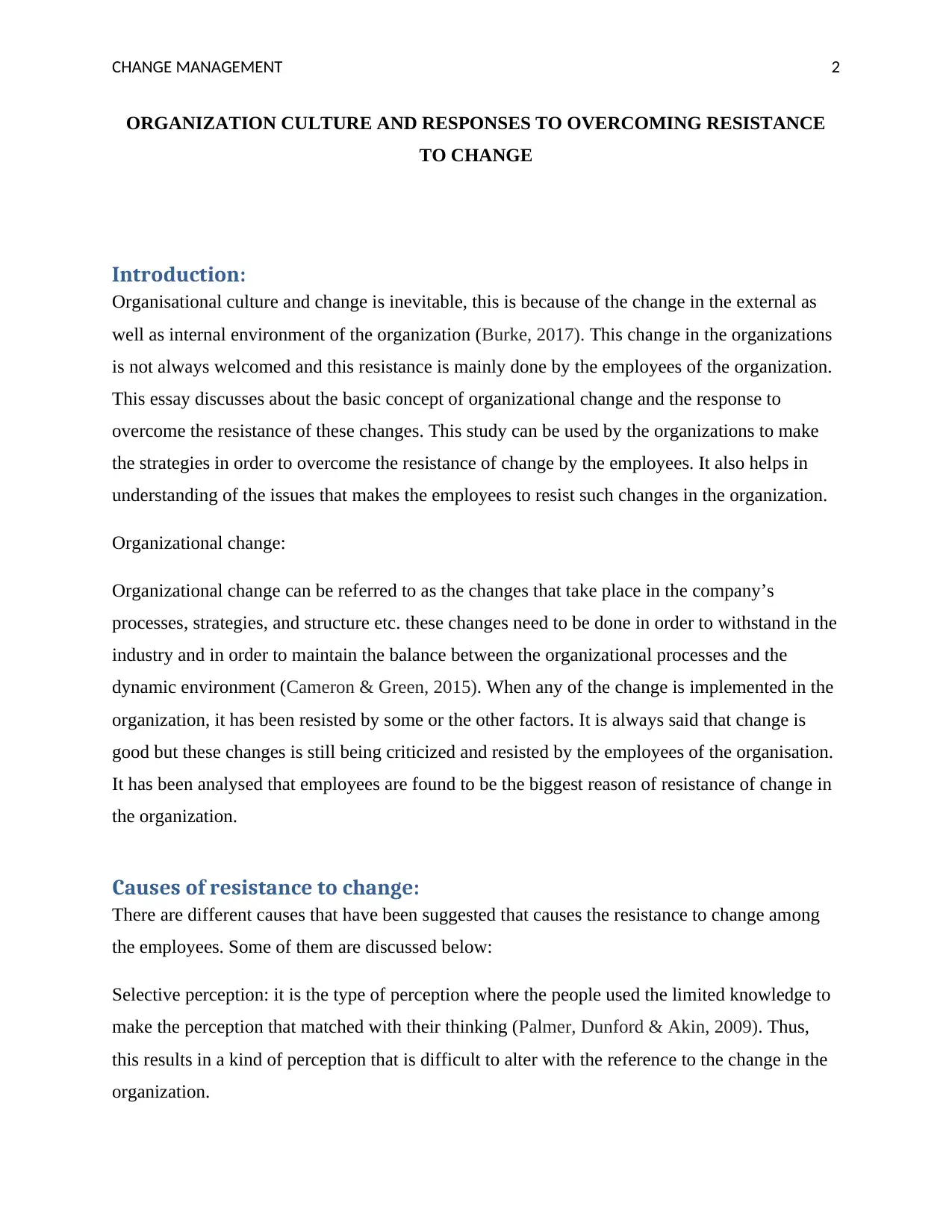
CHANGE MANAGEMENT 2
ORGANIZATION CULTURE AND RESPONSES TO OVERCOMING RESISTANCE
TO CHANGE
Introduction:
Organisational culture and change is inevitable, this is because of the change in the external as
well as internal environment of the organization (Burke, 2017). This change in the organizations
is not always welcomed and this resistance is mainly done by the employees of the organization.
This essay discusses about the basic concept of organizational change and the response to
overcome the resistance of these changes. This study can be used by the organizations to make
the strategies in order to overcome the resistance of change by the employees. It also helps in
understanding of the issues that makes the employees to resist such changes in the organization.
Organizational change:
Organizational change can be referred to as the changes that take place in the company’s
processes, strategies, and structure etc. these changes need to be done in order to withstand in the
industry and in order to maintain the balance between the organizational processes and the
dynamic environment (Cameron & Green, 2015). When any of the change is implemented in the
organization, it has been resisted by some or the other factors. It is always said that change is
good but these changes is still being criticized and resisted by the employees of the organisation.
It has been analysed that employees are found to be the biggest reason of resistance of change in
the organization.
Causes of resistance to change:
There are different causes that have been suggested that causes the resistance to change among
the employees. Some of them are discussed below:
Selective perception: it is the type of perception where the people used the limited knowledge to
make the perception that matched with their thinking (Palmer, Dunford & Akin, 2009). Thus,
this results in a kind of perception that is difficult to alter with the reference to the change in the
organization.
ORGANIZATION CULTURE AND RESPONSES TO OVERCOMING RESISTANCE
TO CHANGE
Introduction:
Organisational culture and change is inevitable, this is because of the change in the external as
well as internal environment of the organization (Burke, 2017). This change in the organizations
is not always welcomed and this resistance is mainly done by the employees of the organization.
This essay discusses about the basic concept of organizational change and the response to
overcome the resistance of these changes. This study can be used by the organizations to make
the strategies in order to overcome the resistance of change by the employees. It also helps in
understanding of the issues that makes the employees to resist such changes in the organization.
Organizational change:
Organizational change can be referred to as the changes that take place in the company’s
processes, strategies, and structure etc. these changes need to be done in order to withstand in the
industry and in order to maintain the balance between the organizational processes and the
dynamic environment (Cameron & Green, 2015). When any of the change is implemented in the
organization, it has been resisted by some or the other factors. It is always said that change is
good but these changes is still being criticized and resisted by the employees of the organisation.
It has been analysed that employees are found to be the biggest reason of resistance of change in
the organization.
Causes of resistance to change:
There are different causes that have been suggested that causes the resistance to change among
the employees. Some of them are discussed below:
Selective perception: it is the type of perception where the people used the limited knowledge to
make the perception that matched with their thinking (Palmer, Dunford & Akin, 2009). Thus,
this results in a kind of perception that is difficult to alter with the reference to the change in the
organization.
⊘ This is a preview!⊘
Do you want full access?
Subscribe today to unlock all pages.

Trusted by 1+ million students worldwide
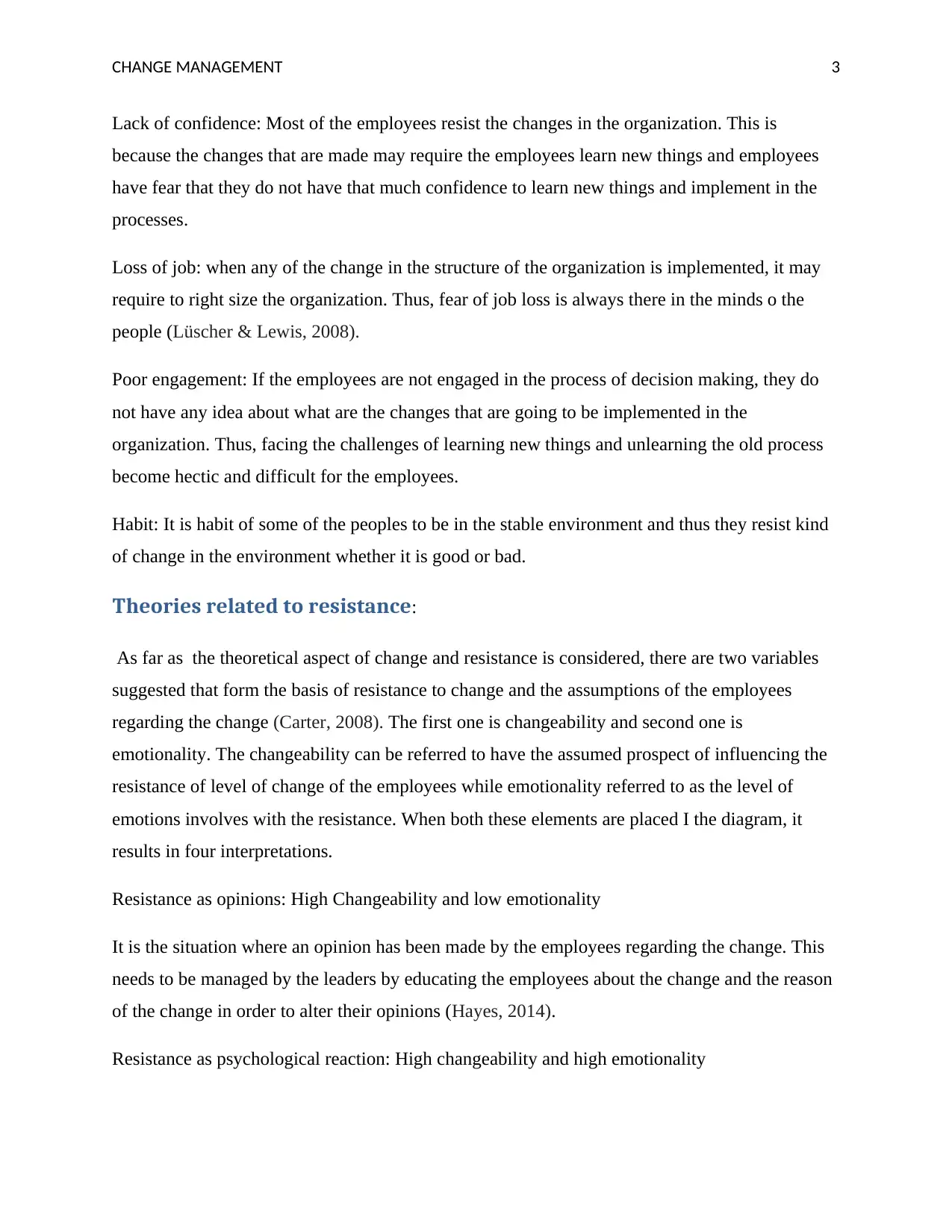
CHANGE MANAGEMENT 3
Lack of confidence: Most of the employees resist the changes in the organization. This is
because the changes that are made may require the employees learn new things and employees
have fear that they do not have that much confidence to learn new things and implement in the
processes.
Loss of job: when any of the change in the structure of the organization is implemented, it may
require to right size the organization. Thus, fear of job loss is always there in the minds o the
people (Lüscher & Lewis, 2008).
Poor engagement: If the employees are not engaged in the process of decision making, they do
not have any idea about what are the changes that are going to be implemented in the
organization. Thus, facing the challenges of learning new things and unlearning the old process
become hectic and difficult for the employees.
Habit: It is habit of some of the peoples to be in the stable environment and thus they resist kind
of change in the environment whether it is good or bad.
Theories related to resistance:
As far as the theoretical aspect of change and resistance is considered, there are two variables
suggested that form the basis of resistance to change and the assumptions of the employees
regarding the change (Carter, 2008). The first one is changeability and second one is
emotionality. The changeability can be referred to have the assumed prospect of influencing the
resistance of level of change of the employees while emotionality referred to as the level of
emotions involves with the resistance. When both these elements are placed I the diagram, it
results in four interpretations.
Resistance as opinions: High Changeability and low emotionality
It is the situation where an opinion has been made by the employees regarding the change. This
needs to be managed by the leaders by educating the employees about the change and the reason
of the change in order to alter their opinions (Hayes, 2014).
Resistance as psychological reaction: High changeability and high emotionality
Lack of confidence: Most of the employees resist the changes in the organization. This is
because the changes that are made may require the employees learn new things and employees
have fear that they do not have that much confidence to learn new things and implement in the
processes.
Loss of job: when any of the change in the structure of the organization is implemented, it may
require to right size the organization. Thus, fear of job loss is always there in the minds o the
people (Lüscher & Lewis, 2008).
Poor engagement: If the employees are not engaged in the process of decision making, they do
not have any idea about what are the changes that are going to be implemented in the
organization. Thus, facing the challenges of learning new things and unlearning the old process
become hectic and difficult for the employees.
Habit: It is habit of some of the peoples to be in the stable environment and thus they resist kind
of change in the environment whether it is good or bad.
Theories related to resistance:
As far as the theoretical aspect of change and resistance is considered, there are two variables
suggested that form the basis of resistance to change and the assumptions of the employees
regarding the change (Carter, 2008). The first one is changeability and second one is
emotionality. The changeability can be referred to have the assumed prospect of influencing the
resistance of level of change of the employees while emotionality referred to as the level of
emotions involves with the resistance. When both these elements are placed I the diagram, it
results in four interpretations.
Resistance as opinions: High Changeability and low emotionality
It is the situation where an opinion has been made by the employees regarding the change. This
needs to be managed by the leaders by educating the employees about the change and the reason
of the change in order to alter their opinions (Hayes, 2014).
Resistance as psychological reaction: High changeability and high emotionality
Paraphrase This Document
Need a fresh take? Get an instant paraphrase of this document with our AI Paraphraser
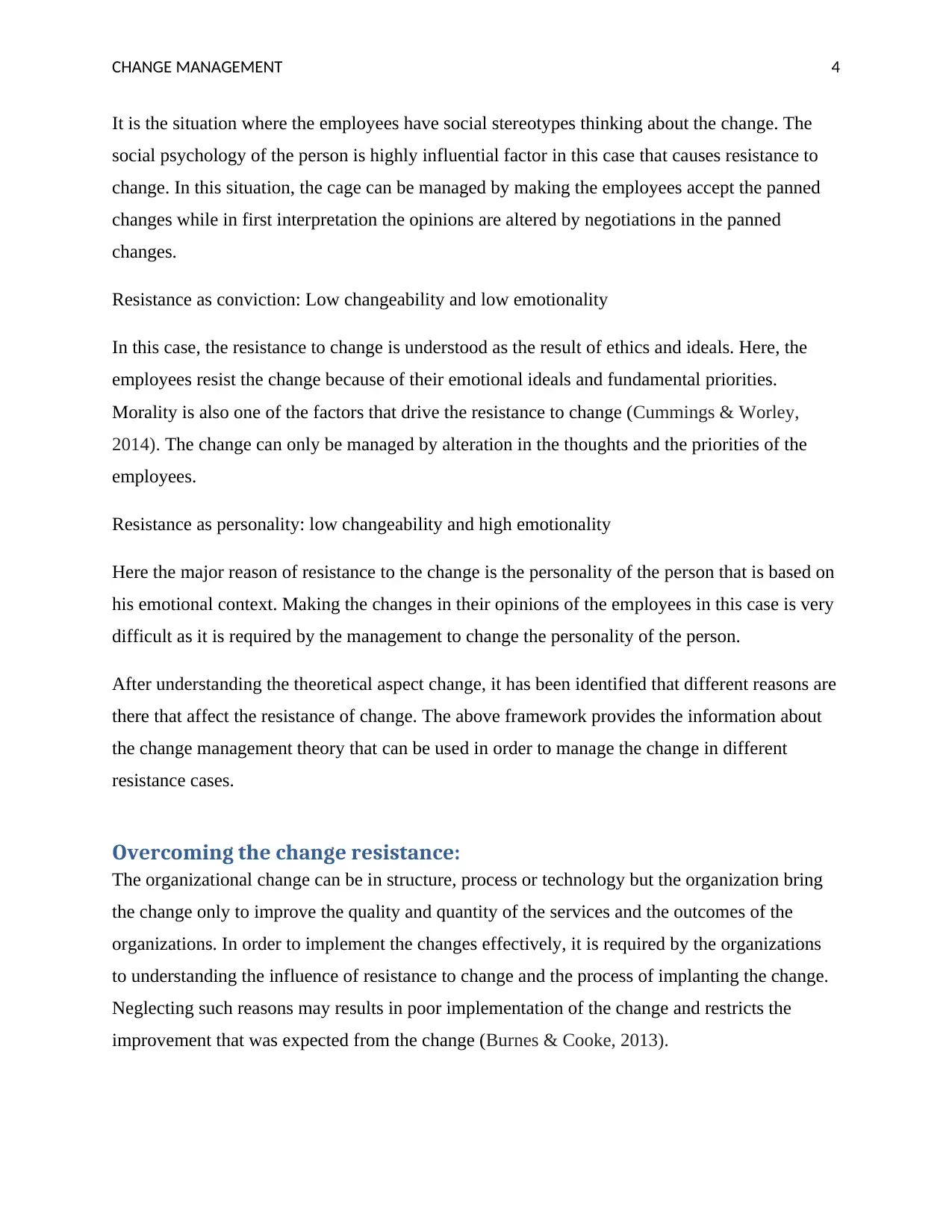
CHANGE MANAGEMENT 4
It is the situation where the employees have social stereotypes thinking about the change. The
social psychology of the person is highly influential factor in this case that causes resistance to
change. In this situation, the cage can be managed by making the employees accept the panned
changes while in first interpretation the opinions are altered by negotiations in the panned
changes.
Resistance as conviction: Low changeability and low emotionality
In this case, the resistance to change is understood as the result of ethics and ideals. Here, the
employees resist the change because of their emotional ideals and fundamental priorities.
Morality is also one of the factors that drive the resistance to change (Cummings & Worley,
2014). The change can only be managed by alteration in the thoughts and the priorities of the
employees.
Resistance as personality: low changeability and high emotionality
Here the major reason of resistance to the change is the personality of the person that is based on
his emotional context. Making the changes in their opinions of the employees in this case is very
difficult as it is required by the management to change the personality of the person.
After understanding the theoretical aspect change, it has been identified that different reasons are
there that affect the resistance of change. The above framework provides the information about
the change management theory that can be used in order to manage the change in different
resistance cases.
Overcoming the change resistance:
The organizational change can be in structure, process or technology but the organization bring
the change only to improve the quality and quantity of the services and the outcomes of the
organizations. In order to implement the changes effectively, it is required by the organizations
to understanding the influence of resistance to change and the process of implanting the change.
Neglecting such reasons may results in poor implementation of the change and restricts the
improvement that was expected from the change (Burnes & Cooke, 2013).
It is the situation where the employees have social stereotypes thinking about the change. The
social psychology of the person is highly influential factor in this case that causes resistance to
change. In this situation, the cage can be managed by making the employees accept the panned
changes while in first interpretation the opinions are altered by negotiations in the panned
changes.
Resistance as conviction: Low changeability and low emotionality
In this case, the resistance to change is understood as the result of ethics and ideals. Here, the
employees resist the change because of their emotional ideals and fundamental priorities.
Morality is also one of the factors that drive the resistance to change (Cummings & Worley,
2014). The change can only be managed by alteration in the thoughts and the priorities of the
employees.
Resistance as personality: low changeability and high emotionality
Here the major reason of resistance to the change is the personality of the person that is based on
his emotional context. Making the changes in their opinions of the employees in this case is very
difficult as it is required by the management to change the personality of the person.
After understanding the theoretical aspect change, it has been identified that different reasons are
there that affect the resistance of change. The above framework provides the information about
the change management theory that can be used in order to manage the change in different
resistance cases.
Overcoming the change resistance:
The organizational change can be in structure, process or technology but the organization bring
the change only to improve the quality and quantity of the services and the outcomes of the
organizations. In order to implement the changes effectively, it is required by the organizations
to understanding the influence of resistance to change and the process of implanting the change.
Neglecting such reasons may results in poor implementation of the change and restricts the
improvement that was expected from the change (Burnes & Cooke, 2013).
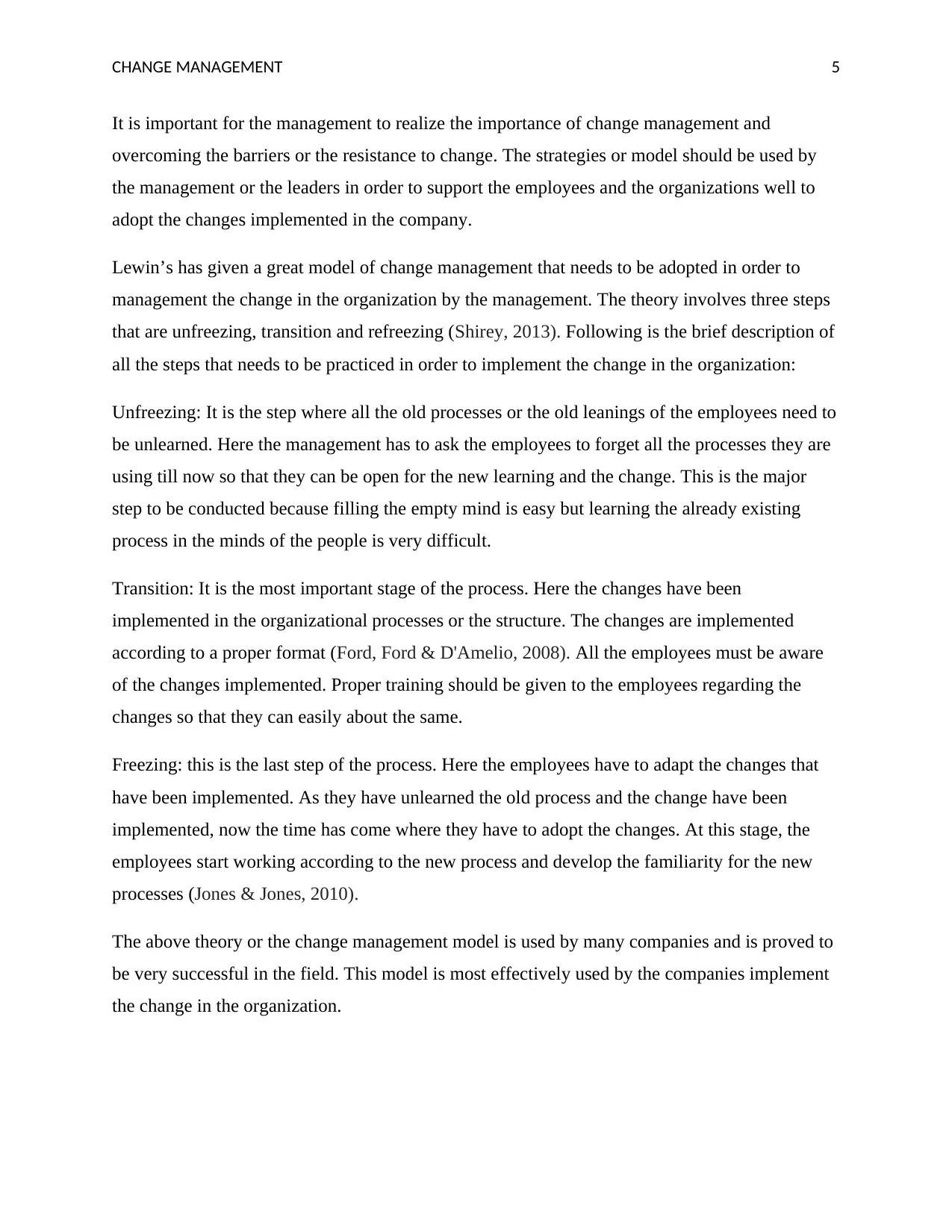
CHANGE MANAGEMENT 5
It is important for the management to realize the importance of change management and
overcoming the barriers or the resistance to change. The strategies or model should be used by
the management or the leaders in order to support the employees and the organizations well to
adopt the changes implemented in the company.
Lewin’s has given a great model of change management that needs to be adopted in order to
management the change in the organization by the management. The theory involves three steps
that are unfreezing, transition and refreezing (Shirey, 2013). Following is the brief description of
all the steps that needs to be practiced in order to implement the change in the organization:
Unfreezing: It is the step where all the old processes or the old leanings of the employees need to
be unlearned. Here the management has to ask the employees to forget all the processes they are
using till now so that they can be open for the new learning and the change. This is the major
step to be conducted because filling the empty mind is easy but learning the already existing
process in the minds of the people is very difficult.
Transition: It is the most important stage of the process. Here the changes have been
implemented in the organizational processes or the structure. The changes are implemented
according to a proper format (Ford, Ford & D'Amelio, 2008). All the employees must be aware
of the changes implemented. Proper training should be given to the employees regarding the
changes so that they can easily about the same.
Freezing: this is the last step of the process. Here the employees have to adapt the changes that
have been implemented. As they have unlearned the old process and the change have been
implemented, now the time has come where they have to adopt the changes. At this stage, the
employees start working according to the new process and develop the familiarity for the new
processes (Jones & Jones, 2010).
The above theory or the change management model is used by many companies and is proved to
be very successful in the field. This model is most effectively used by the companies implement
the change in the organization.
It is important for the management to realize the importance of change management and
overcoming the barriers or the resistance to change. The strategies or model should be used by
the management or the leaders in order to support the employees and the organizations well to
adopt the changes implemented in the company.
Lewin’s has given a great model of change management that needs to be adopted in order to
management the change in the organization by the management. The theory involves three steps
that are unfreezing, transition and refreezing (Shirey, 2013). Following is the brief description of
all the steps that needs to be practiced in order to implement the change in the organization:
Unfreezing: It is the step where all the old processes or the old leanings of the employees need to
be unlearned. Here the management has to ask the employees to forget all the processes they are
using till now so that they can be open for the new learning and the change. This is the major
step to be conducted because filling the empty mind is easy but learning the already existing
process in the minds of the people is very difficult.
Transition: It is the most important stage of the process. Here the changes have been
implemented in the organizational processes or the structure. The changes are implemented
according to a proper format (Ford, Ford & D'Amelio, 2008). All the employees must be aware
of the changes implemented. Proper training should be given to the employees regarding the
changes so that they can easily about the same.
Freezing: this is the last step of the process. Here the employees have to adapt the changes that
have been implemented. As they have unlearned the old process and the change have been
implemented, now the time has come where they have to adopt the changes. At this stage, the
employees start working according to the new process and develop the familiarity for the new
processes (Jones & Jones, 2010).
The above theory or the change management model is used by many companies and is proved to
be very successful in the field. This model is most effectively used by the companies implement
the change in the organization.
⊘ This is a preview!⊘
Do you want full access?
Subscribe today to unlock all pages.

Trusted by 1+ million students worldwide
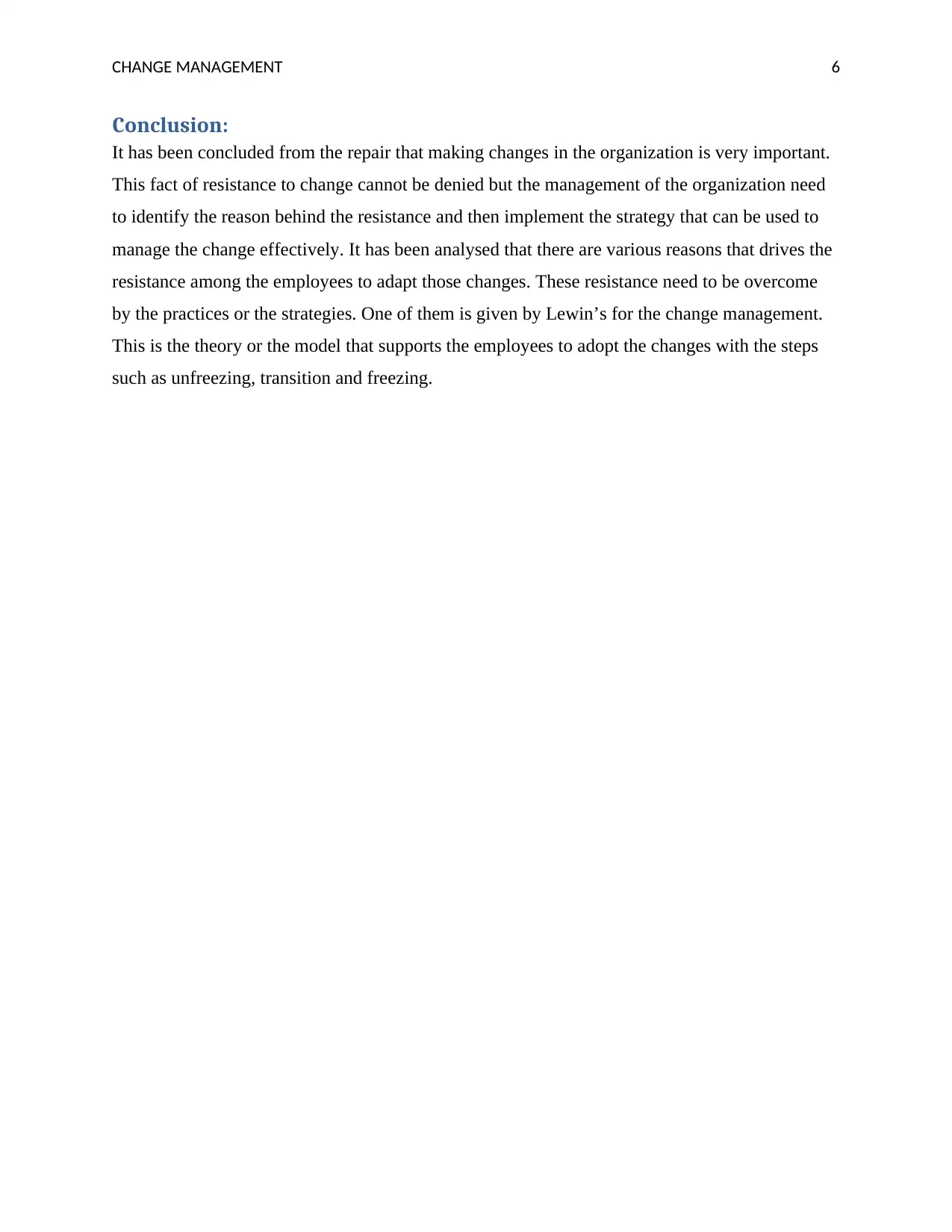
CHANGE MANAGEMENT 6
Conclusion:
It has been concluded from the repair that making changes in the organization is very important.
This fact of resistance to change cannot be denied but the management of the organization need
to identify the reason behind the resistance and then implement the strategy that can be used to
manage the change effectively. It has been analysed that there are various reasons that drives the
resistance among the employees to adapt those changes. These resistance need to be overcome
by the practices or the strategies. One of them is given by Lewin’s for the change management.
This is the theory or the model that supports the employees to adopt the changes with the steps
such as unfreezing, transition and freezing.
Conclusion:
It has been concluded from the repair that making changes in the organization is very important.
This fact of resistance to change cannot be denied but the management of the organization need
to identify the reason behind the resistance and then implement the strategy that can be used to
manage the change effectively. It has been analysed that there are various reasons that drives the
resistance among the employees to adapt those changes. These resistance need to be overcome
by the practices or the strategies. One of them is given by Lewin’s for the change management.
This is the theory or the model that supports the employees to adopt the changes with the steps
such as unfreezing, transition and freezing.
Paraphrase This Document
Need a fresh take? Get an instant paraphrase of this document with our AI Paraphraser
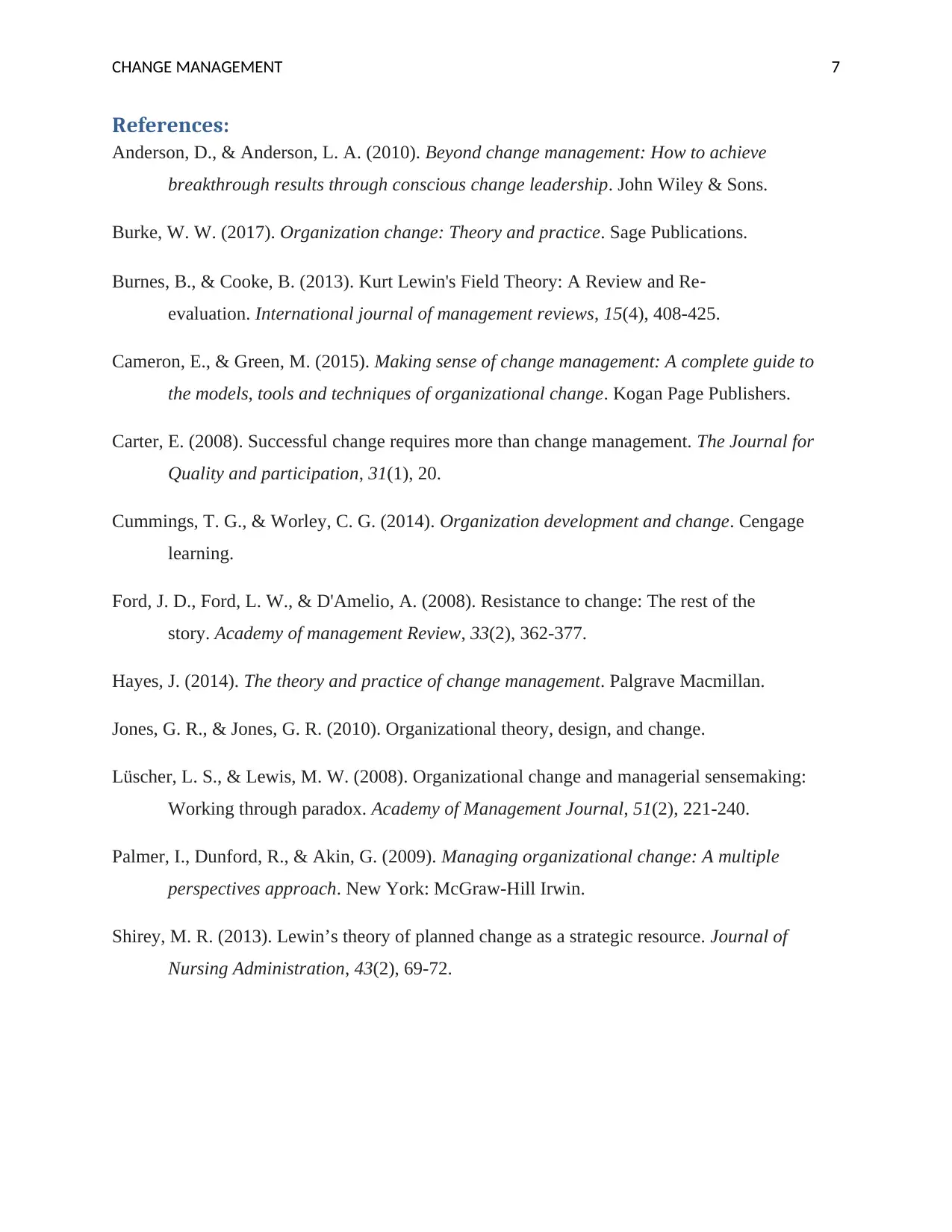
CHANGE MANAGEMENT 7
References:
Anderson, D., & Anderson, L. A. (2010). Beyond change management: How to achieve
breakthrough results through conscious change leadership. John Wiley & Sons.
Burke, W. W. (2017). Organization change: Theory and practice. Sage Publications.
Burnes, B., & Cooke, B. (2013). Kurt Lewin's Field Theory: A Review and Re‐
evaluation. International journal of management reviews, 15(4), 408-425.
Cameron, E., & Green, M. (2015). Making sense of change management: A complete guide to
the models, tools and techniques of organizational change. Kogan Page Publishers.
Carter, E. (2008). Successful change requires more than change management. The Journal for
Quality and participation, 31(1), 20.
Cummings, T. G., & Worley, C. G. (2014). Organization development and change. Cengage
learning.
Ford, J. D., Ford, L. W., & D'Amelio, A. (2008). Resistance to change: The rest of the
story. Academy of management Review, 33(2), 362-377.
Hayes, J. (2014). The theory and practice of change management. Palgrave Macmillan.
Jones, G. R., & Jones, G. R. (2010). Organizational theory, design, and change.
Lüscher, L. S., & Lewis, M. W. (2008). Organizational change and managerial sensemaking:
Working through paradox. Academy of Management Journal, 51(2), 221-240.
Palmer, I., Dunford, R., & Akin, G. (2009). Managing organizational change: A multiple
perspectives approach. New York: McGraw-Hill Irwin.
Shirey, M. R. (2013). Lewin’s theory of planned change as a strategic resource. Journal of
Nursing Administration, 43(2), 69-72.
References:
Anderson, D., & Anderson, L. A. (2010). Beyond change management: How to achieve
breakthrough results through conscious change leadership. John Wiley & Sons.
Burke, W. W. (2017). Organization change: Theory and practice. Sage Publications.
Burnes, B., & Cooke, B. (2013). Kurt Lewin's Field Theory: A Review and Re‐
evaluation. International journal of management reviews, 15(4), 408-425.
Cameron, E., & Green, M. (2015). Making sense of change management: A complete guide to
the models, tools and techniques of organizational change. Kogan Page Publishers.
Carter, E. (2008). Successful change requires more than change management. The Journal for
Quality and participation, 31(1), 20.
Cummings, T. G., & Worley, C. G. (2014). Organization development and change. Cengage
learning.
Ford, J. D., Ford, L. W., & D'Amelio, A. (2008). Resistance to change: The rest of the
story. Academy of management Review, 33(2), 362-377.
Hayes, J. (2014). The theory and practice of change management. Palgrave Macmillan.
Jones, G. R., & Jones, G. R. (2010). Organizational theory, design, and change.
Lüscher, L. S., & Lewis, M. W. (2008). Organizational change and managerial sensemaking:
Working through paradox. Academy of Management Journal, 51(2), 221-240.
Palmer, I., Dunford, R., & Akin, G. (2009). Managing organizational change: A multiple
perspectives approach. New York: McGraw-Hill Irwin.
Shirey, M. R. (2013). Lewin’s theory of planned change as a strategic resource. Journal of
Nursing Administration, 43(2), 69-72.
1 out of 8
Related Documents
Your All-in-One AI-Powered Toolkit for Academic Success.
+13062052269
info@desklib.com
Available 24*7 on WhatsApp / Email
![[object Object]](/_next/static/media/star-bottom.7253800d.svg)
Unlock your academic potential
Copyright © 2020–2025 A2Z Services. All Rights Reserved. Developed and managed by ZUCOL.





